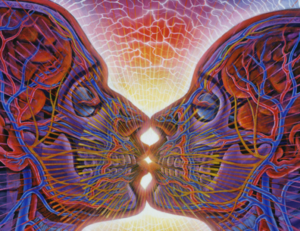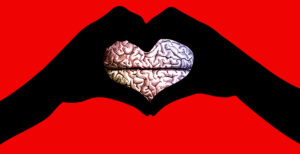Sex is one of the most common ways we feel deep euphoric bliss in our lives. It creates a feeling of pleasure, liberation and euphoric release, releasing bio-energy within our body. Of course, sex can also cause a lot of problems in our lives. There can be negative consequences associated with sex when it is not engaged in or perceived in a sustainable, connected and bliss-giving way. It can affect our self-esteem and throw our intimate relationships out of whack, particularly when it is viewed only as a way to achieve orgasm, not as a shared energetic connection.
By understanding the trends of the underlying hormonal activities associated with sex and orgasm, and how the change in our chemistry affect our moods, behavior, desires and wants, we can work with our body’s hormonal system to make sexual interaction a more spiritual and rewarding experience.
Understanding the Hormones
The main player among the wellbeing hormones is dopamine, also known as the reward hormone. Then there is prolactin, the hormone of satiation, and oxytocin, the love and bliss hormone. All these hormones interact powerfully affecting our moods and desire for intimacy and bonding. And although we might believe that dynamics within the relationship has a conscious element to it, there is also a deep physical hormonal element that contributes to our experience.
Within our brain there is a code that tells us what we need to do to be happy, healthy, wealthy, glowing and living within our life’s purpose. When we do those things, and we experience things such as social interaction, pair bonding and orgasm, our endocrine system responds by releasing oxytocin.
When we first fall in love we become bonded by rising levels of oxytocin, which is the love and cuddle hormone, and we also feel a peak in our dopamine levels. When we start having sex with that person, we experience a big release of dopamine, which comes like a huge wave in the brain during the orgasm. It feels amazing! However this is then followed by a significant drop in dopamine levels immediately after orgasm, which brings hangover-like effects. Generally speaking, the timing of this hangover varies by gender; the reaction tends to be immediate in males and slightly delayed in females.
Crossed Wires
You’re falling in love, making a deep intimate connection and becoming vulnerable. You have sex with the one you’re falling for, and you have an orgasm — followed by a steep decline in dopamine levels.
 At this point, the male impulse goes more or less like this: “Ok, I’m done. I don’t have any more energy, I’m just gonna go to sleep” or “I’m gonna watch TV for a bit”. The female may feel disappointed or rejected; she still wants to cuddle, stay connected and lay in this loving space.
At this point, the male impulse goes more or less like this: “Ok, I’m done. I don’t have any more energy, I’m just gonna go to sleep” or “I’m gonna watch TV for a bit”. The female may feel disappointed or rejected; she still wants to cuddle, stay connected and lay in this loving space.
After the orgasm, the man and the woman enter different biological and hormonal cycles that can cause a disconnection, as they are not on the same page. The male is responding to the decline in dopamine and testosterone while the female is high in oxytocin levels, the intimacy hormone.
As most of us don’t have much awareness of this hormonal experience, it is not uncommon for females to begin creating stories in our mind to explain our male partner’s sudden withdrawl — that he doesn’t like us or he just used us for sex, that there’s something missing in the relationship or not enough intimacy, that we might be better off with a more spiritually evolved partner who would stay in this loving space with us, and so on and so forth. We might even start remembering the connection we shared when we first met (when oxytocin levels were at their highest) which seemingly disappeared after our relationship became sexual, or diminished as time went by.
In reality, we are each just experiencing our biological nature.
Oxytocin by itself is considered to make us indiscriminate in its bonding influence. Under its influence, we may feel a bond towards “any” person that we are sexually or even physically intimate with.
Cravings for Novelty and Dopamine
 Our levels of dopamine, the reward hormone, tend to rise in response to the excitement that of things that are new and novel. Think about the time, for example, when you bought your car – how excited you were. And now, when you look at it every time, most likely you don’t feel anything towards it.
Our levels of dopamine, the reward hormone, tend to rise in response to the excitement that of things that are new and novel. Think about the time, for example, when you bought your car – how excited you were. And now, when you look at it every time, most likely you don’t feel anything towards it.
When we get into a relationship, it comes with a sense of novelty and newness created by this reward-like system. You were looking for a partner, and boom — there’s someone you’re connecting with, having an interaction or a sexual encounter.
And because your needs are being met, you’re experiencing a sense of a reward, a biological prize of sorts. Over time, there’s less of that sense of novelty as the peaks of dopamine, testosterone, and prolactin levels subside. We may feel symptoms of hormonal withdrawal, almost like addiction, which can make us feel helpless and dejected.
So what’s the antidote?
These are all natural hormonal processes in our bodies. If we understand what’s happening on a biological level, we can teach ourselves to get into the sustainable flow of the love-giving, intimacy-enhancing hormone oxytocin, which doesn’t give us the rollercoaster side-effects of dopamine when that sense of bliss and euphoria subsides.
Dopamine vs. Oxytocin
Known as the “bonding hormone”, oxytocin plays an important role in the neuroanatomy of wellbeing and intimacy. It is associated with various behaviors, including pair bonding and parental behaviors. For that reason, it’s not surprising that both men and women release significantly more oxytocin when they have a baby, because they both need to be a lot more stable and engaged to raise the baby.

Obviously, going out, making new romantic connections and looking for the biological thrill of new partners wouldn’t create a secure environment for the baby to thrive. Oxytocin helps to create the bond of love at a biological level.
Dopamine is the culprit when it comes to addictive behavior. The release of dopamine is short lived but it feels so good that we often feel compelled chase the feeling. It also tends to function by the laws of diminishing returns — the more we have it, the less impactful or satiating the results. Any perceived scarcity of the dopamine-giving object or experience can create feelings of fear and stress, and so we set out to engage in behaviors that fulfill our cravings. Of course, we can get addicted to anything that gives us that high, be it pharmaceutical or hormonal.
In my experience, when the dopamine cycle takes control, we can feel addicted to many different stimuli, e.g. sex, food, alcohol or drugs, or it could be a 21st century addiction like Facebook, internet porn or TV. Before we know, it can us turn into dopamine junkies. We live in a state of constant anxiety, nervousness, feelings of scarcity, and the sense that something vital piece is missing from our lives — and yet somehow is always unattainable. We become distracted, with that recurring (addictive) impulse always at the back of our minds.
But there is a solution to this all-pervasive dopamine addiction, and like most sustainable solutions, it happens to be “substitution” — finding something else that can sustainably fill the void we are trying to fill with our addictive behavior. In the case of dopamine addiction, oxytocin, which is the hormone of love, connection, safety and bliss, counteracts the fear and stress created by the cycle of dopamine spike and drops. So it’s a matter of disengaging the body from a dopamine addiction by learning to trigger oxytocin instead.
Oxytocin Substitution
In my experience working with people on this very problem over the years, I have come to realize that the subconscious mind feels a lot more ease to trade in a lower vibrational drug to a higher vibrational drug. Adopting the mindset of “going cold turkey” activates the potent powers of the dopamine receptors and this biological scarcity creates a sensation in us that leads to cravings.
When you give up something, e.g. alcohol, meat, or change the way you were having sex from a very aggressive way of chasing dopamine to a sweet loving, connected form of sex which triggers oxytocin, there’s always an adjustment period. When I stopped eating meat, for example, it was uncomfortable for a while. I was addicted to it, I really wanted to eat it, and there was a taste, a flavor, a feeling that I used to get from it, which was extremely addictive. I would eat a vegetarian meal and not feel satiation. On a biological level, my body wasn’t just missing the nutrition, it was missing the reward hormone (dopamine) that came with it.
However, when we learn to substitute dopamine behaviors for oxytocin behaviors, and become “addicted” instead to oxytocin, we start looking for a more sustainable “high” — like intimate bonding and spiritual love. The same when you switch to more loving, softer, oxytocin connections and sex – instead of having a rapid release, the body learns to feel satiated with a slow release. It’s like a slow simmer or a slow burn, rather than like a full release all at once, which takes us away from the hormonal rollercoaster of dopamine. It’s a process of retraining ourselves to become “addicted” to subtler, more sustainable vibration, and to a hormone that we have easier access to. As a result, prolactin, which is the hormone of satiation, will then reprogram its circuitry, triggering instead when you behave in a more oxytocin-generating way.
The Full Spectrum: Engaging Oxytocin in Sexual Relationships
Firstly, the “oxytocin way” of having sex takes away the need. The goal of sexual interaction shifts from having an orgasm to being in a euphoric love connection, and re-orients us to a place where we’re feeling satiated by intimacy, even though were not having an orgasm. Instead of getting to a place where we are able to just have that sort of deep release of sensation, the goal of the oxytocin sex is to build and engage in a relationship.
In essence, we are learning to communicate with our body’s energy centers – and those of our sexual partner – in a very intimate way, and to do that we need to relearn the way of the “natural” flow of our body and our hormones.
The endocrine system produces and regulates our body’s hormonal activity. The gland known as the hypothalamus creates oxytocin, and it is stored in the pituitary gland, which then releases it to the rest of the body.
 Like all systems, this works in complex feedback loop; one hormonal function in one gland then triggers the function of other glands in the system. That’s why I strongly recommend developing a full spectrum relationship – a relationship that engages all the elements in the octave of the body’s endocrine system:
Like all systems, this works in complex feedback loop; one hormonal function in one gland then triggers the function of other glands in the system. That’s why I strongly recommend developing a full spectrum relationship – a relationship that engages all the elements in the octave of the body’s endocrine system:
- When you feel you have a higher purpose with a partner, it engages the crown center.
- Having a mental connection, similar mental patterns, being intuitively connected with one another person is a very important purpose of the pineal gland center.
- If you have good physical energy, and a similar range of physical energy, it engages the medulla oblongata, the nervous system center. If one person is extremely active and the other person is not, it can create a disconnection.
- The thyroid connection involves being able to really talk about your innermost feelings and desires, your emotions and your goals in life, and be able to deeply connect and share on a verbal communication level.
- The simple feeling of bonding and love, having a sense of independence while still having a connection, a relationship where you can really be yourself and be loved for it, relates to the thymus gland connection.
- The solar plexus connection is to be able to work together well in the physical dimension, to be able to create things, to be able to support each other and your joint life, to be able to be more powerful in the world together, in your own individual missions and hopefully in your joint purpose of being together.
- The womb and the prostate region has to do with being able to have a wonderful intimate social life, to have loving friends, have your needs met to be in a great community, to be a good fit, be good together as it comes to relating to your greater family.
- And then, finally, we come to the rectum, the root, which is the sex center of the body’s energy octave.
In my experience, the oxytocin connection is reached if we made sure that we have spiraled our energy together and come to a place where we are meeting someone on at least five of those areas – the rest you could work on. That’s a natural part of relationships. But connecting on any less than five areas out of eight can make the relationship quite difficult, not to mention a full spectrum connection difficult to achieve.
If you are meeting someone with the intention of having a full spectrum connection, oxytocin is triggered, naturally and simply. If you’re meeting someone for the purposes of just having sex, you’re skipping all the connections associated with the body’s energy centers and going straight to the sexual center. Oxytocin, which helps to create spiritual bonding on a biological level, also holds the code of your crown energy, which is how you are a divine being and how you are walking the planet and completing your spiritual mission on this planet. All that information is held in your crown center, which is where the oxytocin gets released.
When we experience the release of oxytocin, we feel like our emotional and spiritual needs are taken care of. We feel a strong bond with someone that we can trust. Trust is a huge factor in oxytocin release because, when we feel safe, we feel like we’re in the “right place” and we start functioning from a place of trust and safety, and relax into the relationship. The “soul’s code” triggers the master hormone – oxytocin – which in turn triggers all the rest of the glands in the body, creating a hormonal feedback loop (provided they are healthy enough to receive the messages and are in turn able to contribute to that feedback loop.) But when we’re randomly meeting someone and having sex, we’re not really able to feel that sort of connection, and we’re not able to feel the safety associated with the oxytocin loop.
In my opinion, yes, it is better to avoid just having sex, but rather to save it as an energy-center interaction with someone after we’ve connected through the other major parts of the body spectrum. And then, once were connecting in this deeper way, we can look into the person’s eyes and feel how deeply we’re connected with them on a soul level, how safe we are with them — and feel the natural flow of oxytocin, without creating a fake bubble of oxytocin (which creates a false sense of connection) or just chasing the dopamine rush of disconnected sex.
Fake Oxytocin Bubbles
We create fake bubbles of oxytocin all the time. Often we meet someone, and although we kind of like them, we may feel that there is not much else happening in that relationship — that is, until we have sex and start releasing oxytocin (as well as dopamine etc.) Then all of a sudden, the brain begins to trick us into believing that we share all the other points of the spectrum: the full spectrum.
We begin to feel differently about them, and even though we don’t have the full spectrum connection with that person, or even the makings of it, we start fooling ourselves into believing this person could be the “right person”, simply because we decided to have sex – and release oxytocin – which biologically can make you feel bonded with whomever.
However, most people know before they have sex with someone whether they have a full spectrum connection with that person. But if we compromise the full spectrum connection and have sex with that person anyway, we experience a confusing biological backlash that is completely hormonal in nature. We feel bonded to that person in a way that can feel like a full spectrum connection, since our biology tells us through the release of oxytocin that we are more intimate and more bonded with that person than we truly are. This can cause all kinds of confusion, and heartache.
To be clear, I am not moralistic about it, just realistic. A lot of people think that abstaining from sex until we are in a loving (full spectrum) relationship is an issue of morals, or adherence to religious doctrines. But this principle is grounded in biology, and a desire not to be fooled by it. Before you release oxytocin, listen to your bliss instinct, to your guiding system, otherwise you are playing with hormonal fire. You start feeling bonded with someone that is not right for you on levels other that sex, and you end up in a situation (like so many of us have before) where it is hard for you to let them go even though you know deep down that you don’t share that full spectrum connection with that person.
Light Bulb Moment!
For me it took quite a bit of experimentation to get to this important realization. You see, I come from a very conservative Indian background, and was taught by my parents and my culture not to have sex before marriage. And then when I went to study in Australia, casual sex was not only accepted, it was the norm; if you went on a few dates, it was almost expected. I went from one end of the spectrum to the other, curious to explore — but I ended up feeling really horrible about myself.
Every time I would have sex with someone, I felt like their “code” would start integrating with mine, and since that feeling of bonding was not reciprocated, I took quite a hit in my self-esteem. Of course, I wasn’t as conscious of everything that was going on at that stage, personally or biologically, and I couldn’t understand why I was not feeling good.
I didn’t know back then that by body was producing oxytocin, the bonding hormone, or that sharing a sexual experience and tapping into the energetic “code” of your partner starts integrating their energy into your own. Now I know, if we don’t share the highest vibrational energy – the full spectrum – then we leave the next morning unconsciously picking up all of those vibrations, some of which feel connected with our energy centers, and many that don’t.
I realized that I had to go back to my original way of being, not because of cultural expectations or conditioning, but because I was able to see the value in myself and really begin to love my own vibrational “code”, and the stability of my personal being. I learned only to interact and relate to another human being sexually if the energetic spiral we shared was going to bring an overall sensation of bliss, and we both feel better about who we are, and our connection, as a result.
 Now, when it comes to sexual relationships, I am more deeply on my soul path rather than experiencing confusion and loss, or disconnection from my spiritual path, forgetting who I really was for several days after a sexual encounter and grieving for a connection that really wasn’t there in the first place.
Now, when it comes to sexual relationships, I am more deeply on my soul path rather than experiencing confusion and loss, or disconnection from my spiritual path, forgetting who I really was for several days after a sexual encounter and grieving for a connection that really wasn’t there in the first place.
I found a very similar experience with alcohol. I didn’t drink, but was socially encouraged to start drinking. It felt fun for several hours… but what about the next day when I have to go and serve my purpose, connect with people and share my love and my vibrations? It was counter-productive to being more deeply connected to my spiritual path. So it’s important to realize that anything that doesn’t bring you closer or doesn’t make you more aligned with who you are, more aligned to that love, to that confidence, to that beauty — whether you’re a male or female — is not the right way for you.
That’s when I realized that dopamine addiction and the dopamine-chasing way of life — the seeking of a constant, immediate reward — was not the way I wanted to go.
Heavy Consequences
Due to my experience with DNA activation, I noticed that the next day after casual sex, I often felt some heaviness. What I was feeling was the energetic vestiges, the leftover “code” in my body, and it took a while for me to work it out of my system. While I was working out this sort of unprocessed “code”, I realized it was somebody else’s baggage all of a sudden ending up in my field. I also noticed that a lot of other people around me felt that heaviness too.
Normally, we try to counteract that feeling of heaviness. We don’t feel good about ourselves, we feel like something is off, and we associate that feeling of heaviness with loneliness. So we keep looking, searching for another potential mate — and when we find another sexual partner, we feel a bit better, for a little while. But what we end up doing is picking all of this junk energetic “code” from other people, and place it in our “basement” – which gets heavier and heavier. It can also lead to health issues and even weight gain, because the heavier we feel, the more we are try to find satiation — the dopamine high — and we begin a cycle of satiating ourselves with more food, more sex, more alcohol, more whatever it is that works for you.
Sex is very powerful. Understanding it, not just on an emotion level but on a hormonal level, and learning to switch our behaviors toward the flow to oxytocin instead of dopamine — toward finding a sustainable love connection instead of unsustainable addictive dopamine connections — is going to make all the difference.
Replacing Dopamine Sex with Oxytocin Sex
The first step would be to remove the concept of having sex with someone you’re not spiritually connected to. I personally don’t agree with the extreme “no sex before marriage” concept, but I do feel we are better off sharing sexual experiences with someone with whom we feel safe, and making sure there’s a nurturing, loving, sustainable connection, so that we lift each other up in some way through sharing that experience.
Developing the “oxytocin way” in a relationship is blissful, as if you’re having sex all the time. There becomes a divine quality of celebration in that interaction, which expresses itself in the way you cook for that person, care for their needs, bring them flowers, get yourself ready to be beautiful for them etc.

For a long time before you engage in sex, you spend time, maybe even the whole day, preparing yourself. You can feel the oxytocin flow all day, as you anticipate your next interaction. You enter this mode of caring for your body, and caring for your mood. Perhaps you detox in the morning, go out in the sun, and eat an amazing luscious fresh fruit (fruits are basically sexual organs of plants, so you tune into this vibration of sexuality, ripeness, suppleness). You get yourself ready for this incredible ceremony, and you can feel its energy well before you engage in sexual interaction — and well after.
You don’t need to be a tantra expert or master different breathing or movement techniques. The only thing that is important is that you activate your true oxytocin bliss instinct, and then follow it. Let your natural intuition for bliss guide you to the correct vibration, and guide how you prepare yourself to be with them. Hold your partner in the esteem of a divine male or female, as a god or goddess, and focus on all the things you’re going to do to love your partner — to really see and appreciate him or her, and make him/her feel blissful. See your partner as an angelic being and set your intention to connect on higher levels, to exchange “code” with your partner’s higher self.
You can do this by simply tuning into that consciousness and recognizing that we all have within us the animal self, the human self, and the angelic self. That is the starting point: connecting with the angelic self, making sure that your connection is pure, supportive and loving. And once you have established the foundation of the angelic connection, the sky is the limit — because what you’ll realize is that the angels are actually very naughty. ;)
Full spectrum sex is all about going all the way down the spectrum of the body’s energy centers and all the way back up again — knowing that you have the ability to experience the entire spectrum in this way.When you start from this safe, high vibrational place, you start feeling sexier, you feel more energy, more love, and you feel safe to allow your naughty vibes and your raunchiness – your true unbounded sexuality – to start coming out. Then you go ‘full spectrum’. Sharing that deeply intimate part of yourself, you connect on an emotional and energetic level, as well as physical. You connect with each other’s heart and soul as you look into each other’s eyes. And then, you can spiral down into the animal realms, having really naughty, instinctual sex, where your mind is out of the picture, and you are connecting in a deep, powerful physical way.
Problems often come when we go into having this sort of naughty, nasty sex before we make a spiritual connection with our partner. We might feel unsafe, disconnected, like something is off, even ‘dirty’, and by experiencing them alongside the physical dopamine rush that comes with the act of sex, we may eventually create an addiction to those feelings too; to this disconnected sexual paradigm, and to the seeking of behavior that causes those problematic feelings.
But, when we engage in the full spectrum with our sexual partners, there’s a beautiful unfolding that we share, and there is no limit to the variety, kinds and types of sex that we can have together.
It’s not about morals. It’s all about learning the access point to the full spectrum, the place in which our full being is engaged, including our most animalistic instincts. And once you’re there, the bliss instinct is a free instinct; you can do whatever you want to do together and still be in a place of sustainable bliss.
What About The Orgasm?
Traditionally, philosophies like tantra, which explore the spectrum of connection, don’t focus on orgasm. Some philosophies even discourage it, believing it to detract from the experience of connection. However, in the oxytocin way, I don’t feel there are any hard and fast rules, and there are certainly no drawbacks in experiencing orgasm together as part of your full spectrum connection.
When you make an oxytocin connection, and you both stay within it, you will find the quality of your orgasms changes. Men can start to experience internal orgasms, or electrical orgasms, where it feels just as good as having the physical orgasm but the exchange and the release is electrical in nature, and less centered on the root chakra. The energy center that responsible for that electrical energy in the body is the thymus gland center, located in the heart/lung region. So the result can be that you have an incredibly penetrating heart connection with a person, with both partners engaging in this electrical orgasm, making you feel even more connected and even more orgasmic.
Are You Up for a Challenge?
If you already have a partner and want to being experiencing full spectrum sex, take your time, talk about it in advance, prepare yourself and each other.

To full activate oxytocin, the challenge is not just to develop that full spectrum connection but also to remain on the threshold of orgasm. Sex is not a race to orgasm. Allow that sensation to grow and develop, ebb and flow, instead of going over and releasing it. And this applies both for men and women.
Women also benefit from staying on that threshold, so that the blissful orgasmic vibration is sensationally followed and not broken. You’ll know what I mean when you’re practicing it, and most likely you already feel this on a soul level, as our divine legacy is very closely related to our sexual life and sexual paradigms.
If you are not in a relationship, you can still take up this challenge, because the first point of oxytocin connection is with yourself. Everything I have learned about this started by allowing this divine energy to enter my body and activate the bliss hormone, oxytocin, and embodying this angelic connection within myself — until I came to a place where I was blessed with a partner with whom I could sustainably go there. At its deepest level, sexual union is a spiraling together of energy, much like strands of DNA spiral together. But the first step is to first be in sexual union with you. Mastery starts with yourself.
The benefit is that everyday you’ll feel good and send a message to your subconscious mind that you love yourself, care about yourself and you to do something good for yourself. If we know how to actively cultivate a sense of wellness and love that is hardwired within our bodies, we’ll inevitably begin to thrive. We make choices that are from a place of security and happiness, and safety, and we gravitate towards the things – and people – that make us feel more love, make us feel more beautiful, more healthy, more satisfied, more abundant — more bliss.
Bio
Indra is the founder of the Full Spectrum Bliss and the LumenOctave®, a teaching organization dedicated to raising consciousness by incorporating scientific, metaphysical and ancient teachings on “bliss” to enhance sex, love, beauty, health and longevity.
With a background in Psychology and a Master’s degree in Communication, USDA and CDC funded graduate research in Ag and Applied Sciences, and corporate experience in both healthcare and not-for-profit organizations, Indra, with a team of like-minded people, has devoted her life to teaching, research and development of the ultimate tools for human health, happiness and evolution which can be achieved by following the “physical instinct of bliss”. Go to www.fullspectrumbliss.com to join Indra’s courses and access her work.

